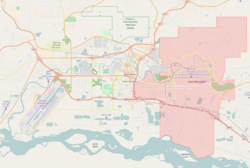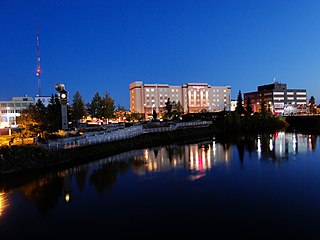
Fairbanks is a home rule city and the borough seat of the Fairbanks North Star Borough in the U.S. state of Alaska.

Chena was a former city in interior Alaska, located in the Fairbanks North Star Borough, Alaska, United States, near the confluence of the Chena and Tanana rivers. It incorporated in 1903 and was disincorporated in 1973. The area is now part of the outskirts of Fairbanks, within the CDP of Chena Ridge. Its heyday was in the first two decades of the 20th century, with a peak population of about 400 in 1907. By 1910 the population had fallen to 138.

SS Nenana is a five-deck, western river, sternwheel paddleship. Two-hundred and thirty-seven feet in overall length, with a 42-foot beam, she was rated at 1,000 gross tons register. Nenana was built at Nenana, Alaska, and launched in May 1933. Marine architect W.C. Nickum of Seattle designed the sternwheeler, which was prefabricated in Seattle and put together at Nenana, Alaska, by Berg Shipbuilding Company. Nenana was built to serve as a packet. She could carry both passengers and freight. Nenana had accommodations for 48 passengers on her saloon deck. Up to 300 tons of freight, including two tons in cold storage, could be carried on her main deck. A Texas, topped by a pilothouse mounted forward in poolboat style, provided staterooms for a portion of the crew of 32. Nenana could push five or six barges on the Yukon River; but, because of sharp bends, only one on the Tanana River.
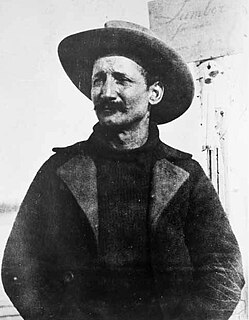
Felice Pedroni, known best to Americans by his Hispanicized alias Felix Pedro, was an Italian immigrant whose discovery of gold in Interior Alaska marked the beginning of the 1902 Fairbanks Gold Rush.

Goldstream Dredge No. 8 is a ladder dredge operated by the Fairbanks Exploration Company from 1928 to 1959. It is located on the old Steese Highway between Fairbanks and Fox in the central part of Alaska.

The history of Fairbanks, the second-largest city in Alaska, can be traced to the founding of a trading post by E.T. Barnette on the south bank of the Chena River on August 26, 1901. The area had seen human occupation since at least the last ice age, but a permanent settlement was not established at the site of Fairbanks until the start of the 20th century.

The Masonic Temple was a historic two-story wooden building at 809 1st Avenue, near the Chena River in Fairbanks, Alaska. It was built in 1906, expanded in 1908, and further altered in 1913 and 1916. Its architecture was "eclectic Renaissance Revival", a style that had been popular in the "lower 48" United States in the 1880s and 1890s. It was listed on the National Register of Historic Places in 1980.

The Immaculate Conception Church is a historic church and former cathedral at 115 N. Cushman Street in Fairbanks, Alaska, United States.

The Chatanika Gold Camp is a historic gold mining camp at Mile 27¾ of the Steese Highway in Chatanika, Alaska. The camp is set on about 49 acres (20 ha) overlooking Cleary Creek, and consists of thirteen buildings as well as a scattering of old mining tools and equipment. The largest of the buildings are two bunkhouses, finished in corrugated metal. The camp was built in 1925 by the Fairbanks Exploration Company (FEC), which also dug the nearby Davidson Ditch to supply water for the operation of the gold dredges. The Chatanika Camp was the largest of the FEC's mining camps in the Fairbanks area. Five of the surviving buildings date to the initial construction period.
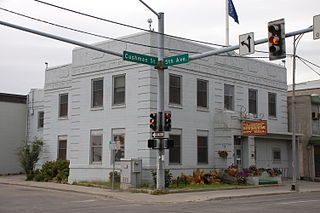
The Old City Hall, now the Fairbanks Distilling Company, is a historic civic building at 410 Cushman Street in Fairbanks, Alaska. It is a two-story Art Deco structure, built out of reinforced concrete in 1935 as a fireproof alternative to the city's previous city hall. The building is roughly T-shaped, with quoining patterns incised in the corners and bands of decoration on a parapet level. The building was originally built to house city offices as well as police and fire stations; the entrances to the fire equipment bays on Cushman Street have been filled in with wood framing and siding. The building was enlarged by extensions to the rear twice, once before 1950, and once after the 1967 floods. The city moved its offices to the adjacent Main School in 1994; the building then housed the Fairbanks Community Museum until it was acquired by Fairbanks Distilling Company in July 2014.

Constitution Hall houses the student center at the University of Alaska Fairbanks in Fairbanks, Alaska. Completed in 1955, the building was the site that year of the meeting at which the Alaska State Constitution was drafted, a milestone in the territory's drive for statehood. It is a reinforced concrete structure two stories high. The building currently houses a bookstore, barbershop, alumni association offices, and the studios of the student radio station KSUA.

The Mary Lee Davis House is a historic house at 410 Cowles Street in Fairbanks, Alaska. It is now the Alaska Heritage House, a bed and breakfast inn. It is a 1-1/2 story bungalow-style house, set at the northern corner of Cowles and 5th Avenue in a residential area of the city. The exact construction date of the house is uncertain: it was probably complete by 1916, but construction may have begun as early as 1906; it is acknowledged as the city's oldest occupied residence. The unfinished house was purchased by writer Mary Lee Davis and her husband, who finished the building and added a number of its distinctive touches, including the city's first residential coal heating system. After a period of ownership by the Fairbanks Exploration Company, during which it was home to company executives, it went through a succession of owners before being converted to a bed and breakfast.

The Fairbanks Exploration Company was the major economic force in the growth of Fairbanks, Alaska during its gold rush years in the early 20th century. In the 1920s the company built a number of housing units for its workers. A cluster of at least eight of these is known to have survived on the east side of Illinois Street, of which four have retained historical integrity. Located at 505, 507, 521, and 523 Illinois Street, they are all similarly-built Bungalow-style wood frame buildings, 1-1/2 stories in height, with a hip roof and projecting hipped wings. The complex includes a five-stall garage which served all four houses, as well as two greenhouses. At the time of their listing on the National Register of Historic Places in 1997, this group of houses was being rehabilitated for use as a bed and breakfast inn.

The Fairbanks Exploration Company Machine Shop is a historic machine shop in Fairbanks, Alaska, United States. Located behind the Fairbanks Exploration Company administration building at 612 Illinois Street, it is a large single-story steel-frame structure, built in 1927 to serve the company's nearby gold mining operations. Its easternmost section is 16 feet (4.9 m) high, while that on the west is 20 feet (6.1 m) high, in order to accommodate belt-driven equipment and cranes. A tall double door at the center of the east facade is the main entrance. The front of the building housed large belt-driven lathes, while the center had a welding shop, drill presses, and a tool room. A blacksmithy in the back had a sand floor. The building was used by the F.E. Company between 1927 and 1964.

The Fairbanks Exploration Company Manager's House, also known as The White House and the Sisters' Convent, is a historic house at 757 Illinois Street in Fairbanks, Alaska. It is a three-story wood frame structure, five bays wide, with a side gable roof, clapboard siding, and a post-and-beam foundation. An ell extends from the center of the rear. The house was built in 1935-36 by the Fairbanks Exploration Company to house its local vice president and general manager. It is the first Colonial Revival house built in Fairbanks, and is one of the state's finest examples of the style.
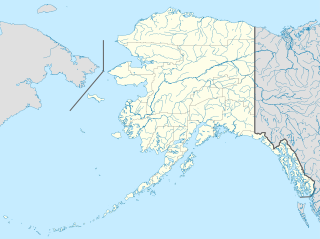
The Fairbanks Exploration Company Dredge No. 2 is a historic gold mining dredge in a remote area of Fairbanks North Star Borough, Alaska, northeast of the city of Fairbanks. It is currently located on the north bank of Fish Creek, shortly northeast of the mouth of Slippery Creek. Its main structure is a compartmented steel hull, 128 feet (39 m) long, 60 feet (18 m) wide, and 12 feet (3.7 m) high, with a 1-2 story superstructure above made of steel and wood framing sheathed in corrugated metal. It has three gantries, and a digging ladder 112 feet (34 m) long at its bow that weights 178,000 pounds (81,000 kg). All of its original operating equipment was reported to be in place in 1999. The dredge was built in 1927 by the Bethlehem Steel Company, and assembled for use in Alaska in 1928. It was operated by the Fairbanks Exploration Company in the Goldstream Valley from 1928 to 1949, and on Fairbanks Creek and lower Fish Creek from 1950 to 1961.

The Fairbanks Exploration Company Gold Dredge No. 5 was a historic gold mining dredge in a remote area of Fairbanks North Star Borough, Alaska, north of the city of Fairbanks. It was last located on Upper Dome Creek, shortly northeast of the mouth of Seattle Creek, about 20 miles (32 km) north of Fairbanks, prior to its being scrapped c. 2012. The dredge was manufactured by the Bethlehem Steel Company in 1928, shipped in pieces to Alaska, and assembled by the Fairbanks Exploration Company on Cleary Creek, where it was used until 1942. It thereafter served on Eldorado Creek (1947–55) and Dome Creek (1955-59) before it was abandoned.

The Old Federal Building is a historic government building at Cushman Street and 3rd Avenue in Fairbanks, Alaska. When it was built in 1933, it was the most northern instance of concrete construction in the United States. It is a large building with three full-height floors and two smaller penthouse levels. The building's Art Deco styling includes V-shaped grooves set in pilasters that separate columns of windows and aluminum panels. The grooves are repeated in concrete spandrels above the top row of windows. Interior decoration includes terrazzo flooring, copious use of marble in walls and floors, and a pressed copper ceiling in the courtroom. The building was designed by Washington, DC architect George N. Ray, and built by William "Mac" MacDonald, who also later built the Federal Building in Nome. It originally housed the federal court, post office, and other federal government offices, and the decision to locate it in Fairbanks was critical to the rise of the city's importance; it now houses private offices.
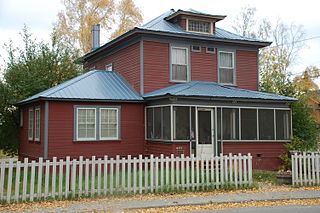
The Falcon Joslin House is a historic house at 413 Cowles Street in Fairbanks, Alaska. Built in 1904, this American Foursquare two-story frame house is the oldest house in Fairbanks set at its original location, and was one of the first frame houses built in what was then a mining camp. The house was built by Falcon Joslin, a Tennessee lawyer who came to Fairbanks and financed construction of the railroad connection to Chena, the head of navigation on the Tanana River. Joslin's railroad ensured the economic success of Fairbanks, which was then competing with Chena as a supply center for miners in the region. In 1930 the house was purchased by Fairbanks Exploration Company, which used it as housing for executives and employees until 1960.

The Rose Building was a historic commercial building in Fairbanks, Alaska. It was located on the west side of Illinois Street, north of the offices of the Fairbanks Daily News-Miner, and was a three-story log structure, capped by a steeply pitched gable roof. It is believed to have been built about 1912 in the mining community of Chena, and was moved to Fairbanks in 1925. It was named for Louis Rose, who purchased the building in 1938. It was, at the time of its demolition, the oldest commercial log building in the city, and was listed on the National Register of Historic Places in 1992. It was demolished in 1998 as part of the Illinois Street roadworks.

